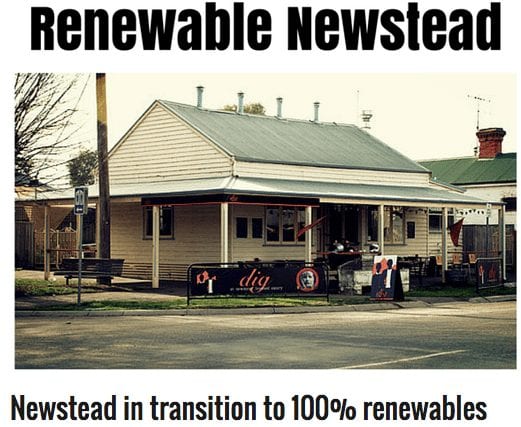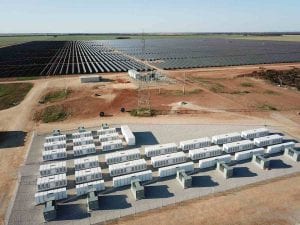A small Victorian town that is hoping to achieve 100 per cent renewable energy as early as 2020 has achieved what appears to be a groundbreaking deal on network charges that could pave the way for similar projects around the country.
Newstead, a town of less than 1,500 people in central Victoria, has negotiated new network charges with its electricity distributor, Powercor, that will remove some of the hurdles of building a small solar farm and sharing the output with the community.
The two-year trial on new network fees will mean that the community can install solar and share the output without being hit by further network charges for each kilowatt they consume.
Equally importantly, they appear to break the nexus between lower energy use and soaring grid charges, and will help ensure that everyone benefits from a local renewable energy transition, and not just those who can afford it.
The changes in the network fees are quite technical, and just part of the huge complexity around electricity charges that has contributed to huge confusion among consumers, and great-profit making by energy utilities.

The Powercor tariffs – specially constructed for the people of Newstead, but with a broader energy market transition in mind – introduce a fixed daily network charge of $1 day, and a monthly “demand” charge of $2/kW. It completely removes fees based on kilowatt-hour consumption.
Tosh Szatow, from energy consultants Energy for the People, which has been advising the Newstead community group, Renewables Newstead, says the new tariffs will have two significant benefits.
One is the way it will make community-owned solar farms, and sharing that solar output, more attractive, because it will eliminate the perverse incentive for individuals to preference rooftop solar, over a shared solar farm, despite the latter option having a lower $/kW installed cost.
The second is that the presence of fixed charges, and the elimination of usage charges, will encourage people to “fuel switch” from bottled gas and wood to a grid which the local community hopes will be 100% renewables within a few years.
It’s a development that should not just benefit the community of Newstead, but also the dozens of other communities around the country which are looking to follow a similar path to 100 per cent renewable energy.
The new tariff means that more electricity can be consumed – from, for instance the local solar farm – without incurring further distribution network charges (which usually make up nearly half of kWh charges), thereby lowering whole of energy costs for households. The only caveat is the demand charge, which means households should avoid switching on everything at the same time.
“We think it’s a major, positive shift for decentralised solar, and if we could get some regulatory sense on customer retail contracts, we could basically lock in gradual declines in prices for loyal retail customers over next 10-15 years,” Szatow told RenewEconomy. “It’s a good policy win.”
Network charges have been a major component of consumer bills for the last five years, accounting for most of the huge bill increases and around 50 per cent of the bill in some cases.
The situation is getting worse for some consumers because as the overall usage goes down – because of energy efficiency and the uptake of rooftop solar – there is upward pressure on network fees, particularly on fixed charges. This has punished low energy users the most, particularly those without solar.
Szatow says that the community of Newstead asked itself: “How do you transition to 100 per cent renewables in a way that ensures everyone can benefit, but not lose out, while maintaining personal choice?
“For the community of Newstead, going 100 per cent renewable is a social project, not an engineering one. And the big question was, how do you pay for distribution assets as a community, equitably, in a world where rooftop solar, and soon batteries, is becoming dominant?”
The Powercor network in Newstead is unconstrained, which means Newstead consumers could use a lot more energy, with no new investment needed in the distribution network to facilitate it. That is the basis for charging zero on a kWh consumed basis. It will encourage consumers to switch fuels from gas and wood burning, to electricity, without incurring more distribution network charges.
Powercor secures its regulated return on capital through the $1/day charge per residential customer, and manages peak demand through the $2/kW per month charge for peak capacity. (In a network with big constraints, perhaps more could be charged to encourage greater uptake of solar and battery storage).
The zero charge per kWh consumed means that it no longer matters where you generate renewable energy. The energy sourced from a solar farm now no longer carries a 10-12c/kWh distribution cost for sharing it among local consumers.
That puts a local solar farm on a par with rooftop solar, and means that people who can’t put solar on the roof, or can’t or don’t want to make the upfront cost, are not penalised. A 2MW solar farm near the township can deliver their 100 per cent renewable energy needs.
Don Culver, a key member of the community group pursuing these changes, says the tariff change would not necessarily save residents money in the short-term, but would ensure that cross-subsidies were removed.
“It means, longer-term, we can make sensible investment decisions as a community as to where the (solar) panels are best put,” he told the local newspaper recently.
“Building a local solar farm is the lowest-cost way for Newstead collectively to get to 100 per cent renewable. It means the greatest benefit is shared by all,” the community group says.
Will a new tariff be enough to transition Newstead to 100 per cent renewables?
Szatow says a new network tariff alone will not be enough, but it does create a sensible economic foundation for investment in decentralised renewables, and for that we should be thankful.
There are a couple of improvements to be made.
For one, regulations currently allow retailers to “lease” rooftop solar to households with a 10 year contract, but prevents them for doing the same contract for a community-owned solar farm. It’s a perverse incentive to prioritise rooftop solar that needs to be addressed.
Secondly, the fixed tariff could be refined. Szatow says a “graded” structure, say charging a lower fixed cost for households that consume less, and a higher fixed cost for those that consume more, would be fairer. But this new trial tariff is still a major step forward.
“It’s a first step to getting a fair foundation for distributed renewables. It’s not the final solution, but it’s a great development.
Newstead is hoping to get to 100 per cent renewables by 2020. It has received funding support from the state government, and support through an MOU with Powercor through data-sharing and negotiations on pricing such as this.
The projects preferred retailer, Diamond Energy, is expected to launch new offerings based around this new network pricing deal later this year. It has asked 448 of the town’s 560 households to complete a survey on energy usage by Macrh 23, so it can look at its options.
And, all going well, a 2MW-3MW solar farm – enough to take the town towards 100 per cent renewables – could be built by the end of next year.
“Building a local solar farm is the lowest-cost way for Newstead collectively to get to 100 per cent renewable. It means the greatest benefit is shared by all,” the community group says.












